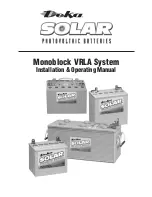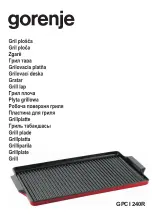
5
SAFETY PRECAUTIONS
Although all valve-regulated batteries have the electrolyte
immobilized within the battery, the electrical hazard associated
with batteries still exists.
Work performed on these batteries
should be done with the tools and the protective equip-
ment listed below.
Valve-Regulated battery installations
should be supervised by personnel familiar with batteries and
battery safety precautions.
WARNING: Risk of fire, explosion or burns. Do not
disassemble, heat above 40°C, or incinerate.
Protective Equipment
Although VRLA batteries can vent or leak small amounts of
electrolyte, electrical safety is the principle but not the only
concern for safe handling. Per IEEE 1188 recommendations,
the following minimum set of equipment for safe handling of
the batteries and protection of personnel shall be available:
1. Safety glasses with side shields, or goggles, or face
shields as appropriate. (Consult application specific
requirements)
2. Electrically insulated gloves, appropriate for the installation.
3. Protective aprons and safety shoes.
4. Portable or stationary water facilities in the battery vicinity
for rinsing eyes and skin in case of contact with acid elec-
trolyte.
5. Class C fire extinguisher.
6. Acid neutralizing agent.
7. Adequately insulated tools (as defined by ASTM F1505
“Standard Specification for Insulated and Insulating Hand
Tools).
8. Lifting devices of adequate capacity, when required.
Procedures
The following safety procedures should be followed during
installation:
(Always wear safety glasses or face shield when working on
or near batteries.)
1. These batteries are sealed and contain no free electrolyte.
Under normal operating conditions, they do not present
any acid danger. However, if the cell jar or cover is dam-
aged, acid could be present.
Sulfuric acid is harmful to
the skin and eyes.
Flush affected area with water immediately and consult a
physician if splashed in the eyes.
Consult SDS for additional precautions and first aid measures.
SDS sheets can be obtained at
www.eastpennmanufacturing.com
2. Prohibit smoking and open flames, and avoid arcing in the
immediate vicinity of the battery.
3. Do not wear metallic objects, such as jewelry, while work-
ing on cells. Do not store un-insulated tools in pockets or
tool belt while working in vicinity of battery. Keep the top
of the battery string dry and clear of tools and other for-
eign objects.
4. Provide adequate ventilation
(per IEEE standard 1187
and/or local codes)
and follow recommended charging
voltages.
5.
Never
remove or tamper with the pressure relief valves,
except for cell replacement. Warranty void if vent valve is
removed.
6. Inspect flooring and lifting equipment for functional
adequacy.
7. Adequately secure cell modules, racks, or cabinets to the
floor.
8. Connect support structures to ground system in
accordance with applicable codes.
RECEIVING & STORAGE
Receiving Inspection
Upon receipt, and at the time of actual unloading, each pack-
age should be visually inspected for any possible damage or
electrolyte leakage. If either is evident, a more detailed inspec-
tion of the entire shipment should be conducted and noted on
the bill of lading. Record receipt date, inspection data and
notify carrier of any damage.
Unpacking
1. Always wear eye protection.
2. Check all batteries for visible defects such as cracked
containers, loose terminal posts, or other unrepairable
problems. Cells with these defects must be replaced.
3. Check the contents of the packages against the packaging
list. Report any missing parts or shipping damage to your
East Penn agent or East Penn Mfg. Co. immediately.
4. Never lift batteries by the terminal posts.
Storage
1. Cells should be stored indoors in a clean, level, dry, cool
location. Recommended storage temperature is 0°F to
90°F (–18°C to 32°C).
2. Stored lead-acid batteries self discharge and must be
given a boost charge to prevent permanent performance
degradation.
0°F to 77°F (-18°C to 25°C) storage:
Batteries should be recharged six months from date of
manufacture.
>77°F (25°C) storage:
Use the chart below for recharge intervals. Voltage readings
should be taken on a monthly basis. Batteries that reach
12.60V per 12V battery (6.30 per 6V battery) or less should
be recharged regardless of scheduled interval. Record dates
and conditions for all charges during storage.
3. If a boost charge is required; the recommended charge is
24 hours at a constant voltage equal to 14.40V per 12V
battery (7.20V per 6V battery).
4. Do not store beyond 12 months.
INSTALLATION
General
Caution should be taken when installing batteries to ensure
no damage occurs. Batteries shall not be dropped, slid, or
placed on rough or uneven surfaces such as tray lips or
grated flooring. Mishandling of batteries could result in
equipment damage or human injury. East Penn will not be
liable for damage or injury as a result of mishandling or
misuse of the product.
Summary of Contents for SOLAR Monoblock VRLA System
Page 1: ...Monoblock VRLA System Installation Operating Manual ...
Page 12: ...10 APPENDIX B Example of typical 3 stage charger ...
Page 13: ...11 APPENDIX C Depth of Discharge vs Freezing Point ...
Page 14: ...12 APPENDIX D Capacity vs Operating Temperature ...
Page 16: ...14 APPENDIX F Charging Current vs Charging Time chart Discharge Voltage Curve ...
Page 17: ...APPENDIX G ...




































